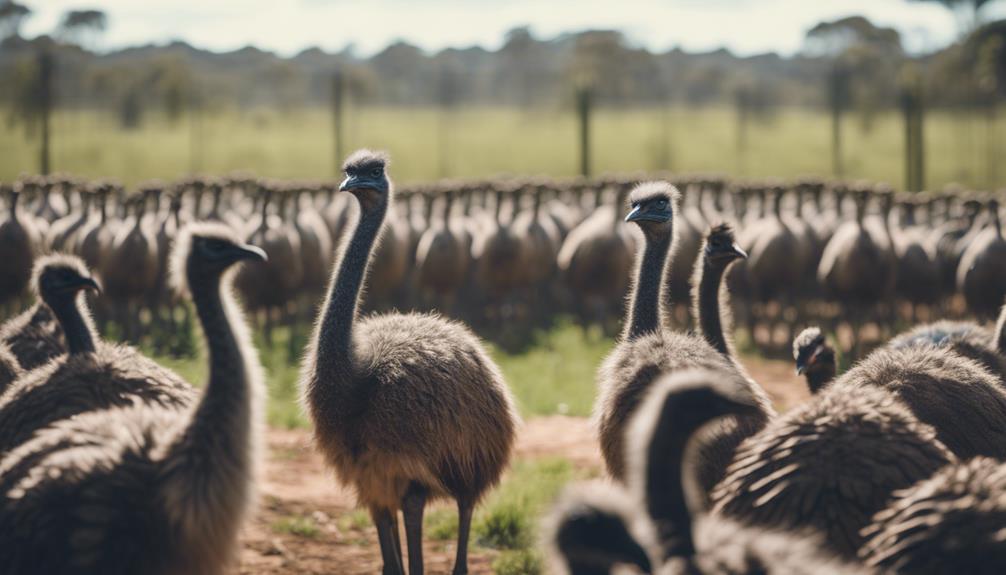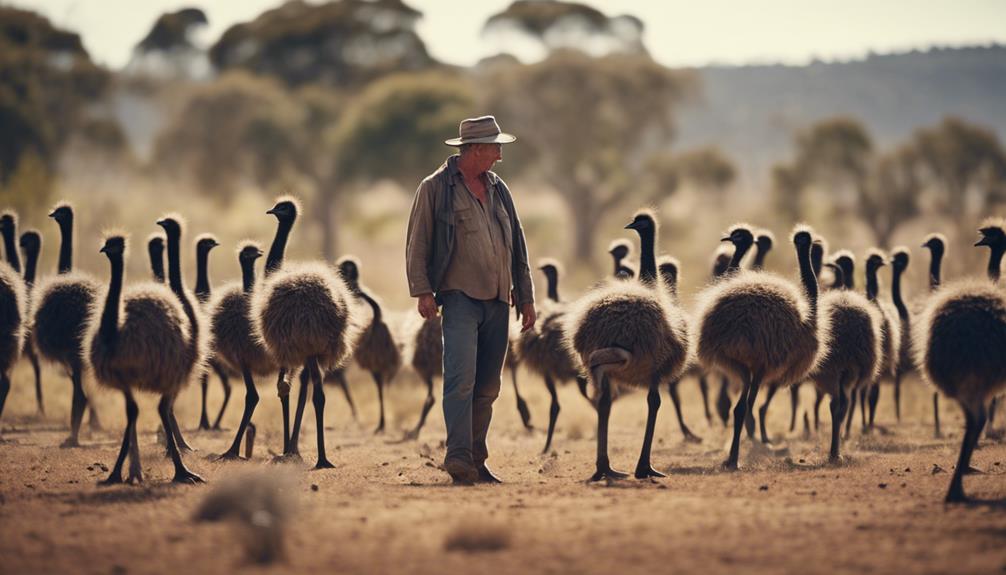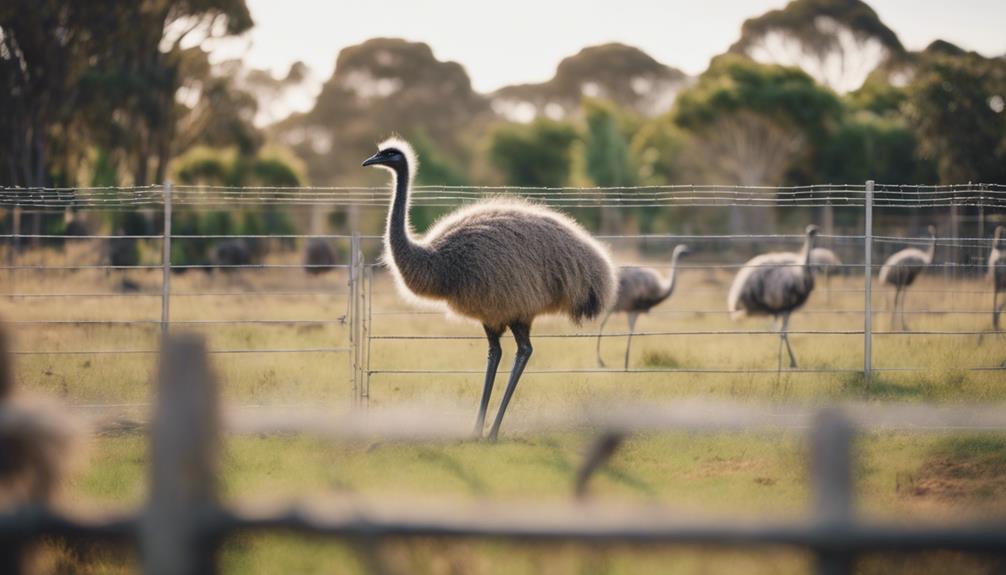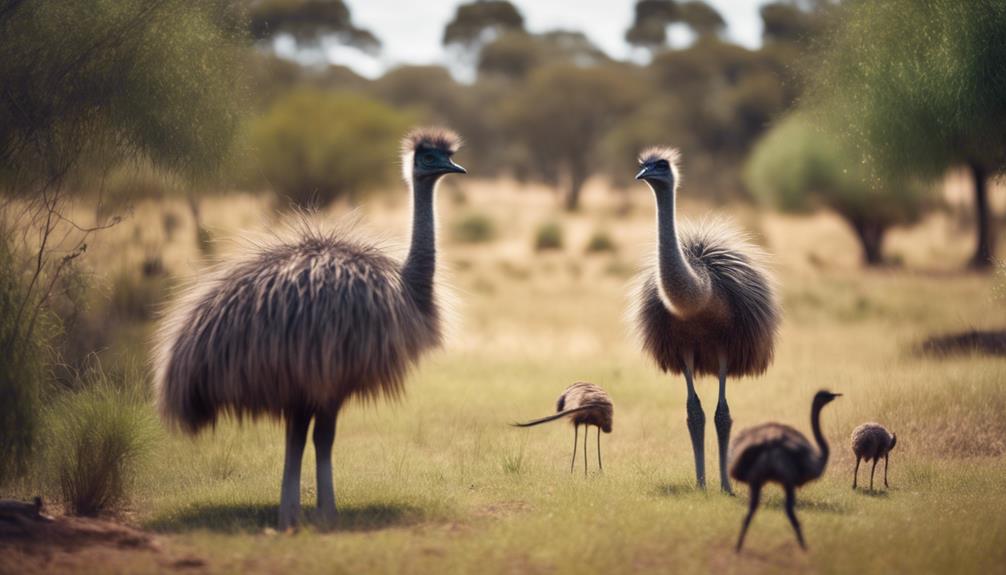
When considering the intersection of emu farming and wildlife conservation, one cannot ignore the Australian example. The emu, a national icon, is both farmed for its meat and oil and plays a crucial role in the ecosystem.
As you contemplate the delicate balance between economic interests and environmental preservation, you may find yourself pondering the intricate strategies required to ensure the coexistence of emu farming and wildlife conservation.
Key Takeaways
- Emu farming must address habitat destruction and species displacement.
- Conservation strategies like sustainable practices and wildlife protection are crucial.
- Regulatory frameworks should prioritize wildlife protection alongside farming profitability.
- Emu farming's future success hinges on biodiversity preservation and sustainable practices.
The Rise of Emu Farming

Emu farming has seen a significant increase in popularity over the past few decades due to the growing market demand for emu products and the potential economic benefits it offers to farmers. To meet this demand, farmers have been implementing advanced breeding techniques to enhance the productivity and quality of their emu stocks.
Through selective breeding, farmers aim to improve desirable traits in emus such as meat quality, feather coloration, and reproductive efficiency. By carefully selecting breeding pairs based on these traits, farmers can develop superior genetic lines that are better suited to meet the demands of the market.
Market demand plays a crucial role in shaping the breeding practices employed by emu farmers. By understanding consumer preferences and market trends, farmers can tailor their breeding programs to produce emus that meet specific market requirements. This proactive approach not only ensures a steady supply of high-quality emu products but also helps farmers capitalize on the economic opportunities presented by the growing demand for emu-based products.
Impact on Wildlife Habitats
The expansion of emu farming operations has been observed to exert significant impacts on the habitats of various wildlife species. Emu farms can alter landscapes and vegetation, affecting the ecological balance of native wildlife.
- Habitat Restoration: Emu farming may lead to the clearing of natural habitats for farming purposes, reducing the availability of suitable habitats for native species.
- Species Displacement: The introduction of emu farms can displace native wildlife species, forcing them to seek new habitats or compete for resources.
- Wildlife Corridors: The construction of emu farms can disrupt wildlife corridors, essential for the movement and migration of various species.
- Ecosystem Fragmentation: Emu farming can fragment ecosystems, creating barriers that impede the natural flow of energy, nutrients, and species interactions.
These impacts highlight the importance of carefully planning and managing emu farming operations to minimize adverse effects on wildlife habitats and promote biodiversity conservation.
Conservation Challenges

Considering the intricate balance of ecosystems and the interdependence of species within them, addressing the conservation challenges posed by emu farming requires a multifaceted approach. Balancing priorities between economic interests and wildlife conservation is a key challenge. Conservation strategies need to be carefully designed to mitigate the impact of emu farming on biodiversity. One of the primary concerns is the potential habitat destruction caused by expanding emu farms. This can lead to fragmentation of ecosystems and loss of crucial habitats for native species. Additionally, competition for resources such as water and food can arise, further complicating the conservation efforts.
| Conservation Challenges | Details |
|---|---|
| Habitat Destruction | Expansion of emu farms leading to habitat loss |
| Resource Competition | Competition for water and food resources |
| Biodiversity Loss | Fragmentation of ecosystems impacting native species |
| Invasive Species | Introduction of invasive species due to farming |
| Pollution | Environmental pollution from farm activities |
Sustainable Farming Practices
To address the environmental impact of emu farming, implementing sustainable practices is imperative in ensuring long-term ecological balance and conservation efforts. When considering sustainable development and environmental stewardship in emu farming, the following practices can aid in wildlife-friendly farming and land management:
- Rotational Grazing: By rotating emus to different sections of the land periodically, overgrazing can be prevented, allowing vegetation to recover and maintain biodiversity.
- Water Conservation: Implementing water recycling systems and utilizing natural water sources efficiently can reduce water wastage and maintain a healthy ecosystem.
- Native Vegetation Preservation: Protecting and restoring native vegetation on the farm provides habitats for wildlife and contributes to the overall health of the ecosystem.
- Integrated Pest Management: Utilizing natural predators, crop rotation, and biological controls can help manage pests effectively without harming the environment.
Emu Farming Regulations

How do current regulations impact emu farming practices and wildlife conservation efforts?
Regulatory compliance plays a crucial role in balancing the needs of emu farmers and wildlife conservation. Regulations ensure that emu farming operations adhere to specific standards regarding animal welfare, land use, and waste management. By enforcing these regulations, authorities can mitigate the environmental impact of emu farming activities, such as soil erosion and water contamination.
Moreover, market demand influences how emu farms operate within regulatory frameworks. Meeting consumer demands while complying with regulations can be challenging, requiring farmers to find sustainable practices that align with ethical considerations. Striking a balance between profitability and environmental responsibility is key to the long-term success of emu farming ventures.
Wildlife Protection Strategies
In implementing wildlife protection strategies, a comprehensive understanding of habitat dynamics and species behavior is essential for effective conservation efforts. To safeguard wildlife populations, consider the following strategies:
- Habitat Restoration: Revitalize degraded habitats by planting native vegetation, creating water sources, and reducing human disturbances to promote biodiversity.
- Community Engagement: Foster partnerships with local communities to raise awareness, involve residents in conservation projects, and address human-wildlife conflicts collaboratively.
- Wildlife Corridors: Establish interconnected pathways to enable safe movement for animals between fragmented habitats, enhancing genetic diversity and resilience.
- Population Monitoring: Utilize scientific methods like camera traps, GPS tracking, and surveys to track population trends, assess threats, and inform adaptive management strategies.
Coexistence Solutions

Implementing coexistence solutions between wildlife and human activities requires strategic planning and innovative approaches to minimize conflicts and promote harmonious interactions. Coexistence strategies such as habitat restoration play a crucial role in maintaining a balanced ecosystem where emu farming can thrive alongside wildlife conservation efforts. By restoring and preserving natural habitats, we create spaces where both emus and native wildlife can coexist peacefully.
Wildlife corridors are another vital aspect of coexistence solutions. These corridors provide safe passage for animals, including emus, allowing them to move between different habitats without facing obstacles such as human infrastructure. By incorporating wildlife corridors into landscape planning, we can help prevent conflicts between emus and other wildlife species.
Effective emu management is essential for successful coexistence. This includes monitoring emu populations, understanding their behaviors, and implementing measures to prevent negative interactions with other wildlife. By carefully managing emu populations and their interactions with the environment, we can foster a harmonious relationship between emu farming and wildlife conservation.
Economic Benefits of Emu Farming
To understand the economic benefits of emu farming, a comprehensive analysis of the industry's potential revenue streams and market dynamics is essential. Emu farming can lead to significant economic growth and capitalize on the increasing market demand for emu products.
Here are four key aspects highlighting the economic benefits of emu farming:
- Diversified Revenue Streams: Emu farming offers multiple income sources, including emu meat, oil, feathers, and leather products, catering to various consumer preferences and market segments.
- Export Opportunities: The global demand for emu products presents lucrative export avenues, allowing emu farmers to tap into international markets and contribute to foreign exchange earnings.
- Value-Added Products: Emu farming enables the development of value-added products like cosmetics, dietary supplements, and health products derived from emu oil, expanding the market reach and enhancing profitability.
- Job Creation: The growth of the emu farming industry creates employment opportunities across various sectors, supporting local communities and contributing to overall economic development.
Emu farming not only offers economic benefits but also plays a crucial role in sustainable development and wildlife conservation efforts.
Wildlife Conservation Efforts

Efforts towards wildlife conservation in the context of emu farming involve integrating sustainable practices to safeguard biodiversity and protect natural habitats. Habitat restoration plays a crucial role in maintaining the balance of ecosystems affected by emu farming activities. By restoring and preserving natural habitats, we ensure the survival of diverse species that share these environments with emus. Community engagement is another key aspect, involving local communities in conservation efforts to raise awareness and promote sustainable practices.
| Conservation Strategies | Description |
|---|---|
| Habitat Restoration | Restoring natural habitats for wildlife species. |
| Community Engagement | Involving local communities in conservation. |
| Ecotourism | Promoting sustainable tourism for conservation. |
| Research Partnerships | Collaborating with researchers for wildlife studies. |
Ecotourism and research partnerships further enhance conservation efforts. Ecotourism provides economic incentives for conservation, while research partnerships contribute valuable knowledge for better wildlife management. By implementing these strategies, we can effectively balance emu farming with wildlife conservation, ensuring the protection of our natural heritage for future generations.
Emu Farming Best Practices
Adopting efficient and sustainable practices is essential for successful emu farming operations. To excel in this industry, consider the following best practices:
- Selective Breeding Techniques: Utilize advanced breeding methods to enhance desirable traits in emus, such as increased meat production or better disease resistance.
- Market Demand Analysis: Regularly assess market trends and consumer preferences to adjust breeding strategies accordingly, ensuring the production aligns with demand.
- Nutritional Management: Implement a well-balanced diet plan for emus to promote optimal growth and health, which can positively impact breeding success.
- Environmental Sustainability: Create a habitat that mimics emus' natural surroundings, fostering a stress-free environment that supports their overall well-being and reproductive capabilities.
Biodiversity Preservation

Consider the crucial role of biodiversity preservation in emu farming operations to maintain ecological balance and support overall sustainability. Habitat restoration plays a vital role in ensuring the preservation of diverse ecosystems where emus thrive. By incorporating practices that promote species diversity, emu farms contribute to the overall health of the ecosystem.
Maintaining ecological balance is essential for the long-term success of emu farming. Emus rely on a variety of plants and insects for their diet, making it crucial to preserve the natural habitats that support these food sources. Through habitat restoration efforts, emu farmers not only secure the necessary resources for their livestock but also aid in the conservation of native species.
The interconnectedness of species within an ecosystem highlights the importance of biodiversity preservation in emu farming. By safeguarding the natural environment and promoting species diversity, emu farmers play a key role in supporting ecosystem health. Embracing practices that prioritize biodiversity preservation ensures a sustainable future for both emus and the surrounding wildlife.
Future of Emu Farming
The future of emu farming hinges on implementing sustainable practices that optimize production efficiency while minimizing environmental impact. To ensure a successful future for emu farming, consider the following:
- Breeding Programs: Emphasize the importance of selective breeding to enhance desirable traits such as meat quality and egg production, meeting market demand effectively.
- Technological Advancements: Utilize cutting-edge technologies like AI for monitoring health parameters and optimizing feed ratios, improving overall efficiency.
- Genetic Diversity: Maintain diverse breeding stocks to prevent inbreeding depression and enhance adaptability to changing environmental conditions.
- Market Demand: Stay attuned to consumer preferences and market trends to adjust production levels accordingly, ensuring a sustainable and profitable emu farming industry.
Frequently Asked Questions
How Do Emu Farms Contribute to Local Economies and Support Rural Communities?
Emu farms provide economic benefits by creating jobs, supporting local businesses, and boosting tourism. They also contribute to community support by engaging with schools, hosting events, and promoting sustainable practices for long-term growth.
What Are the Potential Risks Associated With Emu Farming in Terms of Disease Transmission to Wild Populations?
When raising emus, you must be vigilant about disease surveillance. Failure to implement robust biosecurity measures in emu farms can lead to potential risks of disease transmission to wildlife populations, impacting the delicate balance of ecosystems.
Are There Any Specific Measures in Place to Ensure the Welfare and Ethical Treatment of Emus on Farms?
To ensure the welfare and ethical treatment of emus on farms, industry guidelines enforce strict ethical standards. Farming practices focus on providing adequate space, shelter, and nutrition. Regular monitoring and audits help guarantee compliance with these regulations, promoting emu well-being.
How Do Emu Farms Manage Their Waste and Minimize Environmental Impact on Surrounding Ecosystems?
You manage waste on emu farms by implementing composting systems for manure, using it as fertilizer. To reduce environmental impact, you monitor water usage, avoid chemical runoff, and maintain buffer zones to protect surrounding ecosystems.
What Research Is Being Done to Further Understand the Impact of Emu Farming on Biodiversity and Ecosystem Health in the Long Term?
Wondering about long term studies on biodiversity impacts from emu farming? Researchers are diving deep, exploring the intricate connections between farming practices and ecosystem health. Discoveries await, shedding light on sustainable coexistence.
Conclusion
In conclusion, emu farming presents both economic opportunities and conservation challenges. As the industry continues to grow, it's crucial to implement sustainable farming practices to mitigate the impact on wildlife habitats.
Interestingly, studies have shown that emu farming can help preserve biodiversity by providing alternative income sources for landowners, reducing pressure on native ecosystems.
By finding the balance between farming and conservation, we can ensure a sustainable future for both emus and wildlife.





